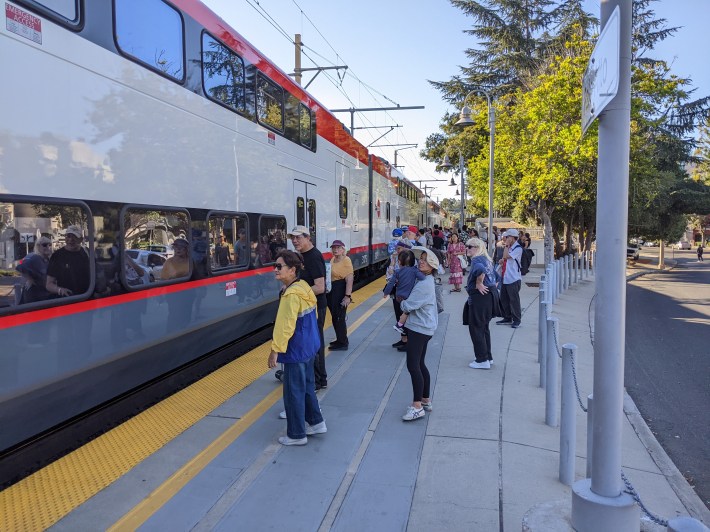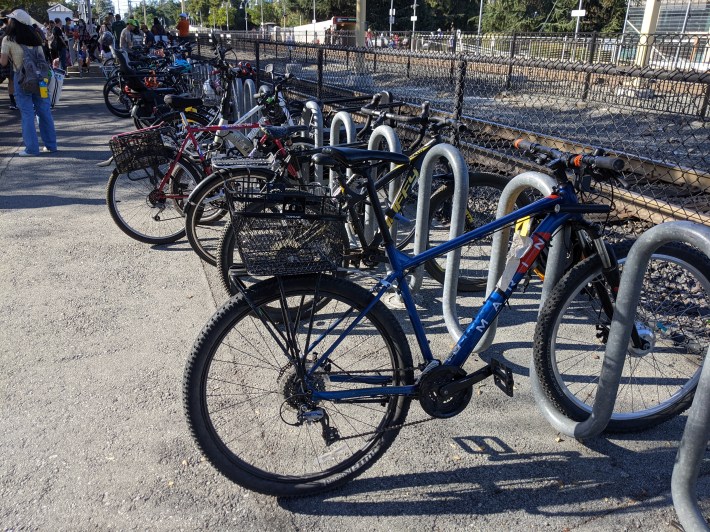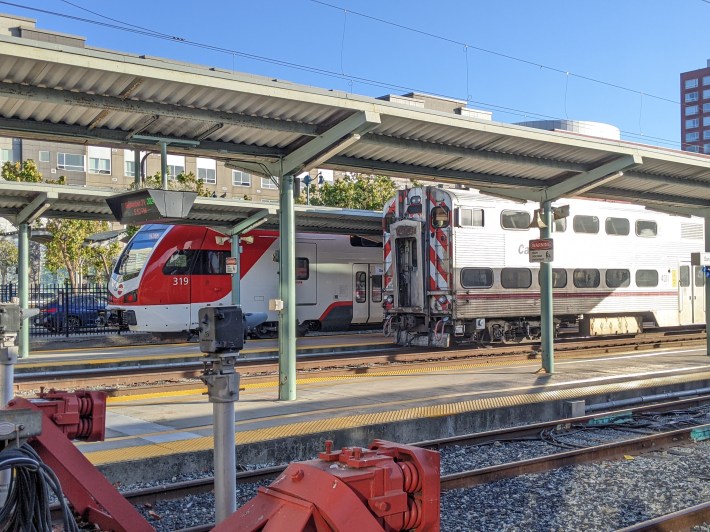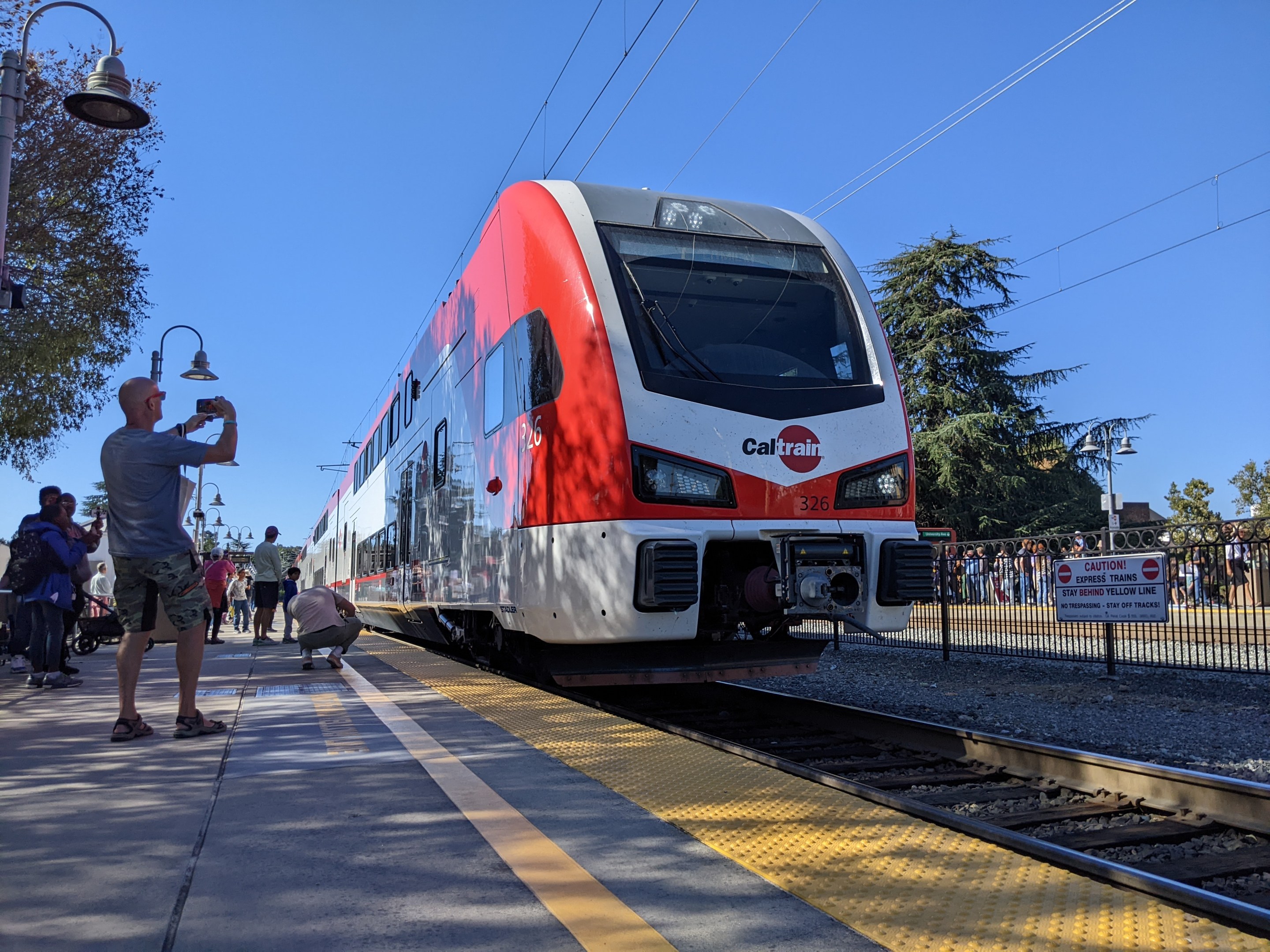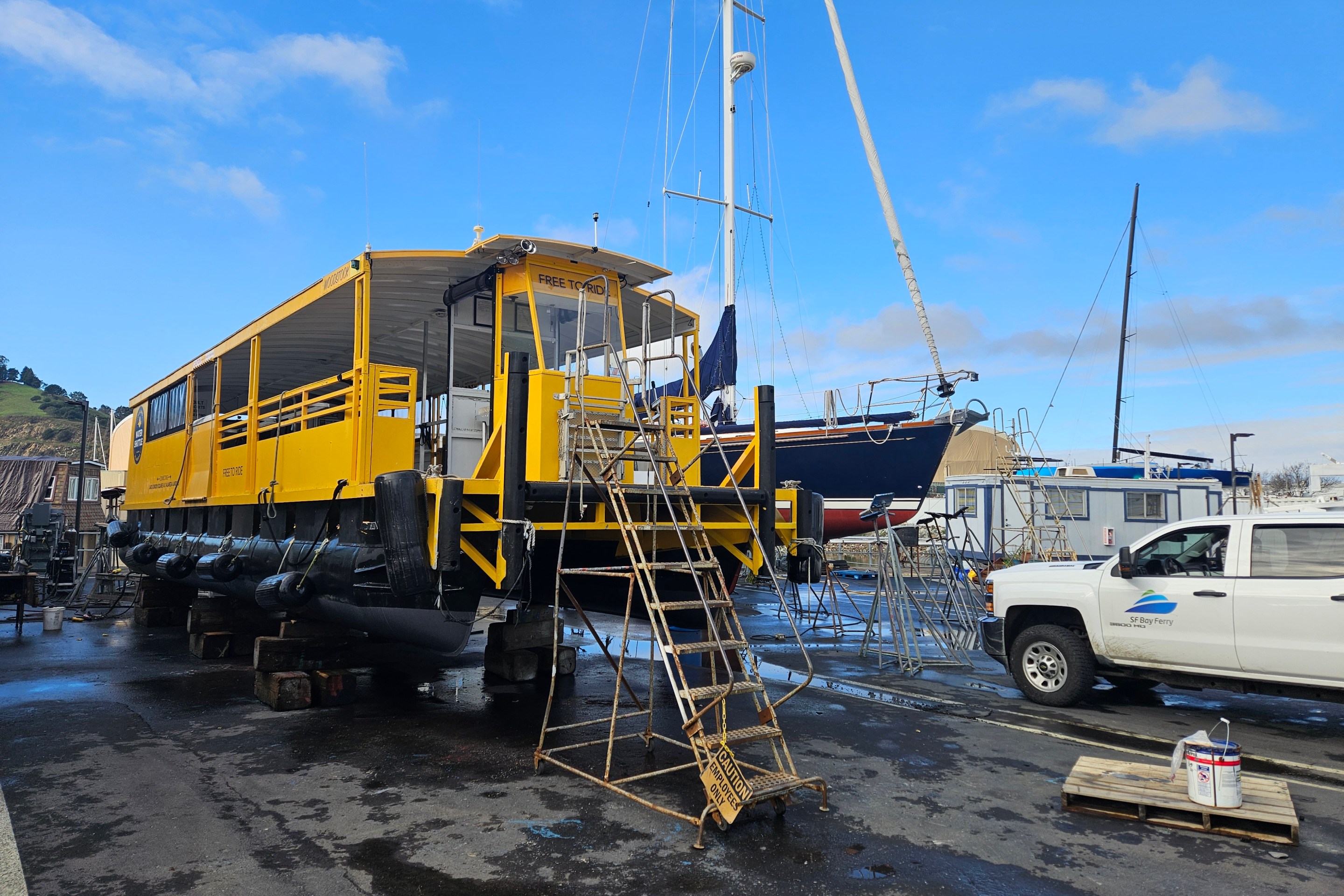Caltrain kicked off fully electrified service between San Francisco and San Jose/Tamien on Saturday. They marked the conclusion of this seven year construction project to eliminate diesel trains—and with it, diesel pollution—with festivals in both Palo Alto and San Mateo. Train fares were waived during this inaugural weekend.
From a Caltrain statement:
Caltrain launched its new electrified schedule, bringing the 160-year-old San Francisco-San Jose rail corridor from diesel power to electric. Caltrain is currently running 100% renewable, zero-emission service from San Francisco to San Jose for the first time.
And:
The new high-performance, state-of-the-art electric trains offer a better experience for Caltrain riders. Caltrain service is now faster and more frequent, with 16 stations receiving trains every 20 to 15 minutes during peak hours, weekend trains arriving twice hourly and express service from San Francisco to San Jose in under an hour. Additionally, the new vehicles offer enhanced amenities, including free Wi-Fi, onboard digital displays, power outlets at each forward-facing seat, energy-efficient lighting, baby-changing tables in the bathroom, security cameras, an improved climate control system and expanded storage under the cantilevered seats. The electric trains also generate less noise than their diesel equivalent, making the trip more enjoyable both for riders and residents that live near Caltrain tracks.

“The electrification of Caltrain is a milestone that we have been working towards for decades, and now everyone we serve can enjoy world class rail travel. I am grateful for the thousands of men and women who have worked hard to make this day a reality,” said Caltrain Executive Director Michelle Bouchard in a statement. “The future of Caltrain has arrived, and I invite everyone to get on board the premier mode of transportation from San Francisco to San Jose.”
Caltrain also reported that some 12,000 people RSVP'd for the celebrations.
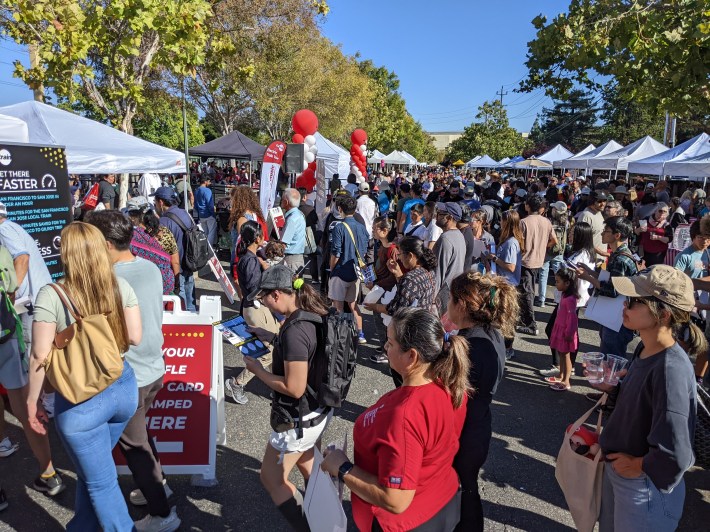
I took the train to Palo Alto on Saturday. Although some electric trains have now been in service for weeks, randomly mixed in with the diesels, their acceleration was handicapped. With the new schedule now in place, the electric trains are accelerating at their full abilities. The difference is noticeable and the trains really take off when they leave the stations.
It felt great to feel such smooth acceleration on a mainline train on this side of "the ponds" from Europe or Asia.
There's a lot to like about this project. In additional to air, noise, speed, and renewable energy, there are efficiency benefits with braking energy no longer being wasted (transforming into heat, as is the case with diesel trains, or gasoline-powered cars). Instead, some of that energy is pushed back into the overhead wire where it is used to accelerate other trains on the line. And energy isn't being wasted hauling around batteries, diesel fuel, or hydrogen (and hydrogen tanks).
"It was a great ride down," said Ameen DaCosta, who is studying transportation planning at Berkeley, at the Palo Alto event. "It was amazing to see so many people excited and nice to have everyone nerding out together."
"It's great celebrating with the community and people who ride bikes and scooters," said Julie Meyerson with the Silicon Valley Bicycle Coalition, which had one of the many tents at the event. She said the bike car on her ride down was relatively free and she appreciated that the step onto the car was so much easier than trying to lift a bike onto the high floors of the old Caltrain equipment. Stephanie Patterson, who stopped by the tent, was concerned about the lack of seats with a clear view of the bike car, which she thinks invites bike theft.

Meyerson was also concerned about Caltrain's choice to only have one bathroom per train. "After this event, I'll take it to the city. I'm a little worried about that part." When I rode down there was a man with a shopping cart struggling to haul a cart up and down the interior stairs of the train to get to the bathroom. Many people have opined that not having multiple bathrooms per train set was a mistake.
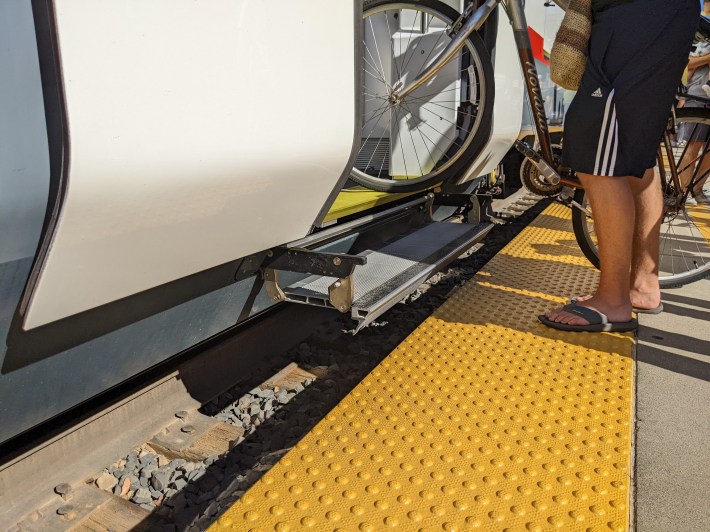
Meanwhile, "Yes on D" advocates used the Palo Alto event to raise support for a November ballot measure that would improve the bus connection to the Palo Alto station.
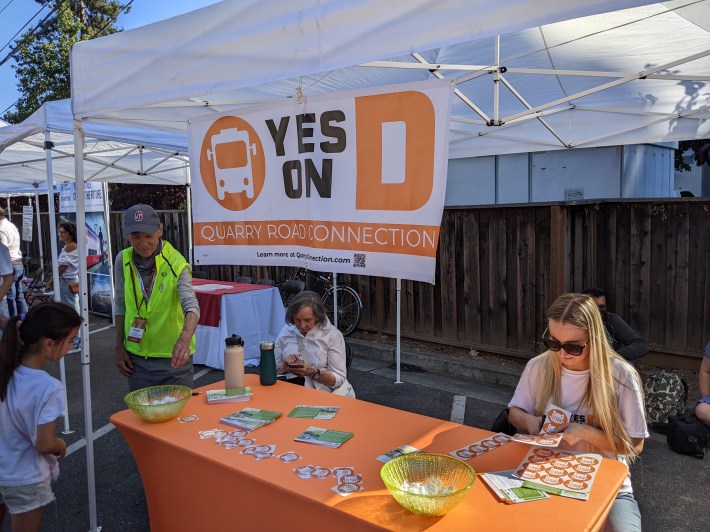
Putting minor critiques aside, it's clear Caltrain electrification will live up to all expectations. Everything the Peninsula's commuter railroad promised is real now: the trains are much more frequent, much quieter, have a brighter roomier feel, and are much smoother running. During the ride back I spent a few minutes just listening to the wheels chattering across switches and other bumps. The older trains transition these places with a bang and a jolt. Instead, the train remained steady and smooth and it was impossible to tell the train was even passing over a switch without listening for it.
Also, my train passed at least two short freight trains parked along the route. The often-heard excuse that the state can't add overhead electric wires on tracks that also have freights is complete nonsense. It's even more obvious now that anybody can take a train up and down the Peninsula under electric wire and see for themselves.
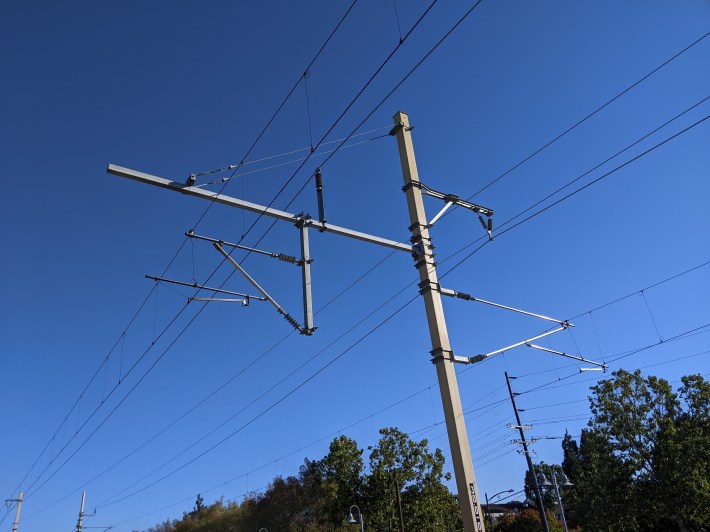
Caltrain has shown the way for other commuter and intercity services in California. Work really should begin immediately on electrifying the trains on the opposite side of the Bay—the Capitol Corridor. Same goes, of course, for the most heavily in-demand lines on MetroLink in L.A. and the Coaster in San Diego. Caltrain is also on course for getting battery-electric trains that also draw power from overhead wire. That will let them extend some electric service to Gilroy. That seems like a good way to extend electrification in the short term, since these trains can recharge as they run under electrified portions of the line.
More pictures of the celebration and trains below:
